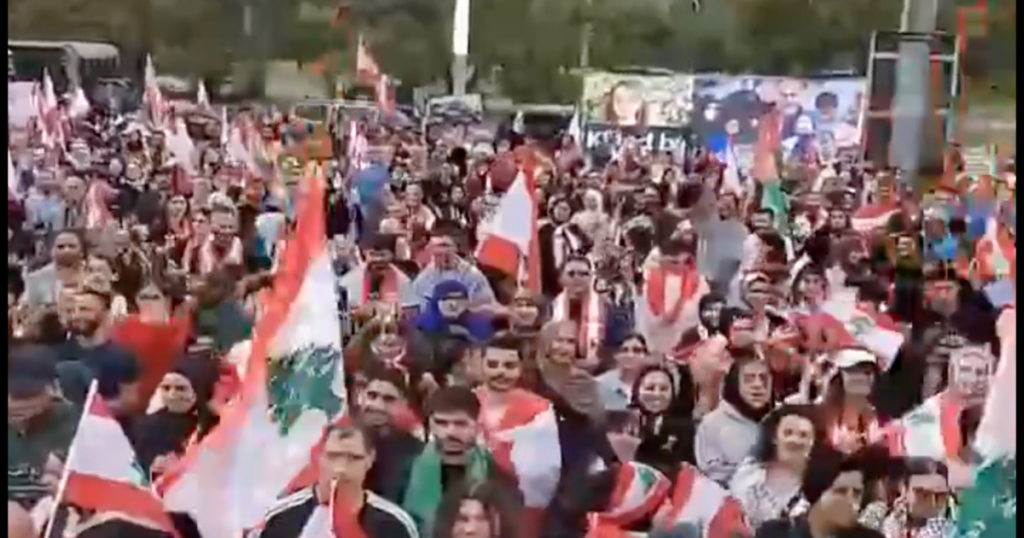In recent events in Dearborn, Michigan, a series of protests have highlighted growing tensions surrounding the Israel-Palestine conflict, especially following the death of Hezbollah leader Hassan Nasrallah. On October 2, 2024, a rally titled “Stand with Lebanon” featured a protester brandishing a sign referencing Nasrallah, who was killed in an Israeli airstrike just days prior. This display was emblematic of the increasingly open support for Hezbollah among certain communities in America, reflecting an alarming trend that some observers link to mass migration policies. The sign’s message echoed a previous incitement made by Nasrallah, which underscored the hostility towards U.S. military personnel and allies in the region. Hezbollah is recognized by the U.S. State Department as a terrorist organization, with a long history of violent actions targeting Americans and Israelis.
The burgeoning support for Hezbollah was further manifested in earlier rallies, particularly on September 25, 2024, where crowds in Dearborn celebrated Nasrallah and Lebanese political figures like Nabih Berri. This display of allegiance was accompanied by openly anti-Israel slogans, revealing a stark polarization within the community. Protesters chanting “Death to Israel!” showcased not only their disdain for the Israeli state but also a willingness to openly endorse violent rhetoric against their perceived enemies. Osama Siblani, a prominent local leader, amplified this sentiment, implying that Israeli citizens should leave their homes due to growing threats from Hezbollah. These developments raise critical questions about the implications of such protests in American society, especially among immigrant communities.
Although the protests drew significant attention online, mainstream media coverage remained minimal, raising concerns about the relative silence in the face of such incendiary behavior. Critics argue that this lack of reporting reflects a broader trend of media negligence concerning acts that could incite violence or foster division within diverse communities in the U.S. Social media platforms, conversely, have become avenues for both outrage and mobilization, with voices condemning the demonstrations capturing considerable traction. Commentators have noted a parallel between the shifts in Dearborn and similar trends observed in Europe in the context of mass migration, suggesting that the absence of adequate integration measures may contribute to radicalization.
The protests, particularly the chants of “Death to America,” signal a deepening ideological chasm that has implications beyond local violence; they hint at broader geopolitical sentiments forming among immigrant populations. Participants appeared to align themselves closely with Hezbollah and its militant agenda, which raises alarms about the increasing normalization of extremist views in certain enclaves of American life. This radicalization is not purely a consequence of local conditions but a reflection of ongoing conflicts in the Middle East, which continue to reverberate within U.S. borders, altering the dynamics of community relations and national discourse.
Michigan, particularly Dearborn—which hosts a significant Lebanese-American population—has witnessed protests that some argue are symptomatic of larger trends rooted in globalist and permissive immigration policies. Critics point to the risks involved when broader societal pressures intersect with narratives of victimhood and resistance, potentially leading some segments of immigrant populations to adopt extremist rhetoric as a form of identity assertion. These developments could signify a profound shift in how certain communities relate not only to American values but also to international conflicts, prompting responses from local authorities and prompting debates about the nature of freedom of expression versus public safety.
In conclusion, the protests in Dearborn encapsulate a complex interplay between local activism, international conflict, and the challenges of integration in multicultural contexts. As immigration continues to shape the American landscape, the events unfolding in Michigan serve as a microcosm of a larger narrative involving the impact of foreign conflicts on domestic soil. The witnessing of such overt support for groups like Hezbollah raises pivotal inquiries about the role of communities in the U.S., the responsibilities they carry in fostering peace, and the dangers posed by unchecked extremist sentiments. As the nation grapples with these realities, the need for dialogue, understanding, and community cohesion has never been more pressing.

